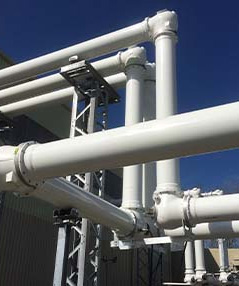T155 DUAL GAS GIL
One 420 kV GIL design for SF₆ and SF₆-free
GE Vernova's Grid Solutions offers cutting-edge gas-insulated lines (GIL) up to 420 kV designed for both SF6 and SF6-free applications, leveraging more than 60 years of expertise in gas-insulated substation technology. This unique flexible design allows transmission system operators (TSOs) to purchase the SF6 version initially with the option to transition easily to the SF6-free g³ solution, ensuring compliance with emerging regulations on fluorinated greenhouse gases without compromising operational performance.
This new dual gas GIL reflects GE Vernova's strong commitment to reducing carbon footprint. Our g3 gas used as insulating medium allows us to provide TSOs a fully SF6-free version, achieving a 99% reduction in CO2-equivalent emissions of the gas contribution to global warming without increasing the diameter or the thickness of the GIL. Despite this major step toward decarbonization, the GIL maintains the same performance and ratings as its SF6 based counterpart. Further enhancements include a reduction in gas mass by more than 15% and an innovative gas sealing system that offers improved tightness, with the total sealing length cut in half compared to previous designs.
The path to decarbonization is further supported by GE Vernova's GRiDEA portfolio, which includes the T155g SF6-free GIS. These solutions help achieve a lower carbon footprint over a 40-year substation life cycle compared to traditional SF6 products. Customer benefits include field-proven reliability, low electromagnetic fields, a low total cost of ownership, and smart grid readiness, underpinned by extensive field experience with more than 200 km of SF6-GIL and more than 30 km of g³ GIL installations worldwide.
Transitioning to SF6-free systems has never been so easy, already today even at 420 kV.
T155 DUAL GAS GIL
One 420 kV GIL design for SF₆ and SF₆-free
GE Vernova's Grid Solutions offers cutting-edge gas-insulated lines (GIL) up to 420 kV designed for both SF6 and SF6-free applications, leveraging more than 60 years of expertise in gas-insulated substation technology. This unique flexible design allows transmission system operators (TSOs) to purchase the SF6 version initially with the option to transition easily to the SF6-free g³ solution, ensuring compliance with emerging regulations on fluorinated greenhouse gases without compromising operational performance.
This new dual gas GIL reflects GE Vernova's strong commitment to reducing carbon footprint. Our g3 gas used as insulating medium allows us to provide TSOs a fully SF6-free version, achieving a 99% reduction in CO2-equivalent emissions of the gas contribution to global warming without increasing the diameter or the thickness of the GIL. Despite this major step toward decarbonization, the GIL maintains the same performance and ratings as its SF6 based counterpart. Further enhancements include a reduction in gas mass by more than 15% and an innovative gas sealing system that offers improved tightness, with the total sealing length cut in half compared to previous designs.
The path to decarbonization is further supported by GE Vernova's GRiDEA portfolio, which includes the T155g SF6-free GIS. These solutions help achieve a lower carbon footprint over a 40-year substation life cycle compared to traditional SF6 products. Customer benefits include field-proven reliability, low electromagnetic fields, a low total cost of ownership, and smart grid readiness, underpinned by extensive field experience with more than 200 km of SF6-GIL and more than 30 km of g³ GIL installations worldwide.
Transitioning to SF6-free systems has never been so easy, already today even at 420 kV.
g³ gas GIL Specifications
| RATINGS | |||
| Voltage | kV | 362 | 420 |
| Standards | IEC/IEEE | IEC/IEEE | |
| Frequency | Hz | 50/60 | 50/60 |
| Withstand voltages, to earth - Short-duration power-frequency - Switching impulse - Lightning impulse | kV kV (peak) kV (peak) | 650 1050 1425 | 650 1050 1425 |
| Continuous current | A | 4,000/5,000 | 4,000/5,000 |
| Short-time withstand current | kA | 63 | 63 |
| Peak withstand current | kAp | 170 | 170 |
| Temperature | °C | -30 | -25/-30 |
